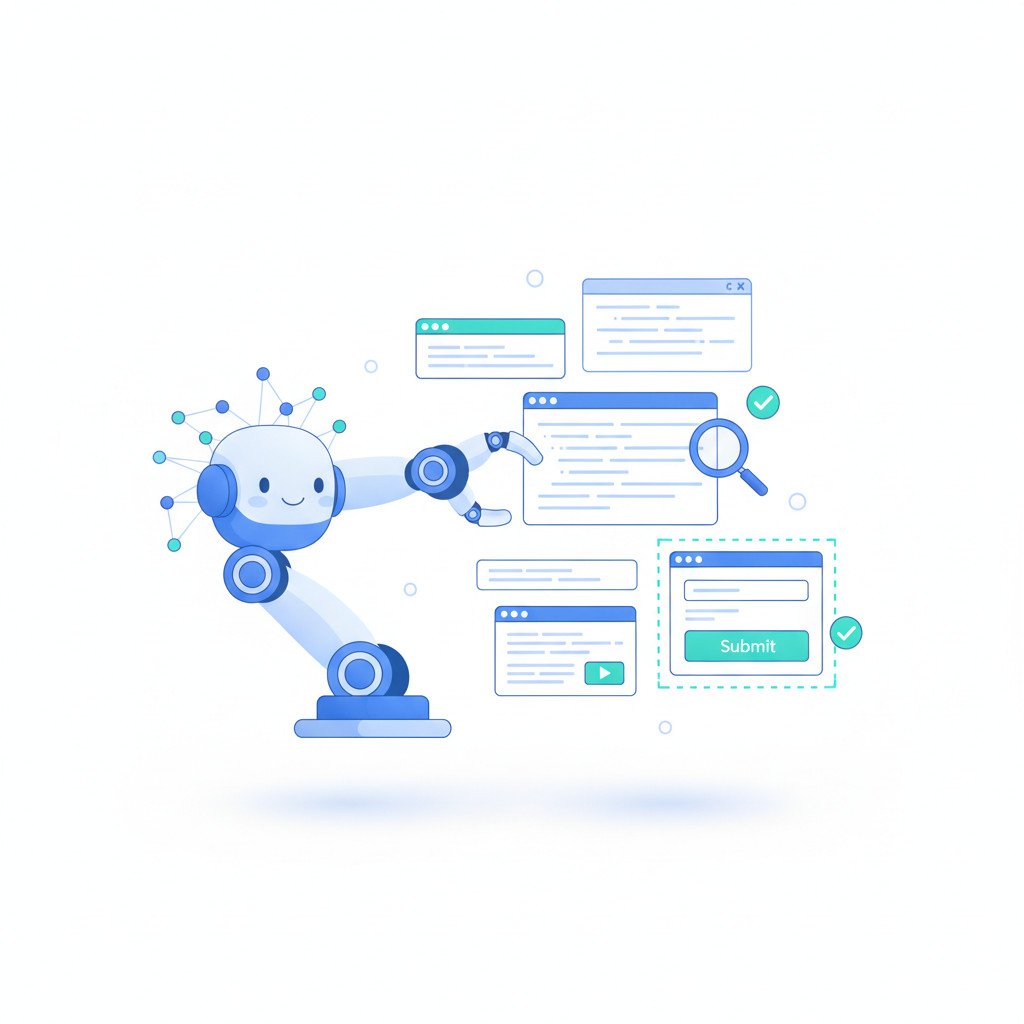AI in software testing is transforming how teams find, prioritize, and prevent bugs. Today, machine learning, NLP, and predictive analytics speed test case generation and selection. As a result, self-healing automation and no-code interfaces reduce test maintenance and friction.
However, buyers must separate genuine learning systems from clever rule-based marketing claims. For example, modern platforms learn from requirements, user stories, commit logs, and bug histories to suggest meaningful test cases, update brittle DOM selectors by analyzing visual patterns and context so tests self-heal, prioritize regression suites based on historical failure risk to speed CI/CD pipelines, run parallel and cross-platform executions to cut feedback loops, and surface accessibility and WCAG issues at scale; therefore, QA roles will shift toward supervising AI, validating generated tests, and designing strategy while teams focus on higher-value testing such as exploratory and usability checks.
Importantly, organizations must evaluate vendors by measuring learning behavior over time rather than accepting marketing claims.
Transformative Automation in Testing
AI in software testing has revolutionized the quality assurance (QA) landscape by streamlining processes and enhancing testing precision. Leveraging AI-driven testing tools, QA teams are witnessing substantial improvements in efficiency. These tools automate mundane tasks, allowing testers to focus more on designing test logic and validating results. For example, platforms like Mabl and Testim exemplify this advancement by predicting test outcomes based on historical data.
AI Testing Tools: Enhancing Accuracy and Reliability
AI-powered solutions rely on machine learning and natural language processing (NLP) to improve the accuracy and reliability of software testing. Here are some of the key innovations:
- Self-healing Automation: AI identifies UI changes and updates selectors. This capability reduces test maintenance, ensuring test scripts remain valid without manual intervention.
- Predictive Analytics: AI tools predict potential failures by analyzing past bugs and commit logs, enabling teams to focus on risk-based testing.
- Accessibility Testing: AI efficiently detects Web Content Accessibility Guidelines (WCAG) issues, supporting inclusive web design development.
Machine Learning in QA: Beyond Automation
The role of machine learning in quality assurance transcends basic automation. According to industry experts, AI’s ability to learn from user stories, requirements, and historical data translates into more sophisticated test case generation. Quote from an industry expert: “The role of QA engineers will shift toward AI supervision and strategy — designing better test logic, validating predictions, and managing automated insights.”
Key Benefits of AI in Software Testing
- Efficiency: Automated regression testing reduces time-to-market and enhances test accuracy.
- Parallel Testing: Supports execution across multiple platforms, devices, and environments for faster feedback.
- Scalability: AI-driven tools like Applitools support large-scale operations with minimal human intervention.
By adopting AI in software testing, teams are not only enhancing the quality of releases but also transforming the QA process into a more dynamic and proactive function.
To explore more about how AI intersecting with diverse technological facets, refer to articles like Why AI infrastructure and multi-platform compute strategy matters now? and How AI agents and tool discovery for web automation?.

| Tool | Key AI Features | Ease of use | Integration capabilities | Pricing |
|---|---|---|---|---|
| Mabl | ML-driven test maintenance; self-healing selectors; predictive test selection; NLP-based test creation | Low-code UI; quick onboarding; good for teams moving from manual to automation | Integrates with Jenkins, GitHub Actions, CI/CD pipelines, cloud browsers, issue trackers | Free trial; SaaS; tiered pricing; contact sales |
| Testim | ML for flakiness reduction; smart locators; visual validation; parallel test execution | Visual editor plus code options; moderate learning curve | CI/CD, cloud device farms, Jira, GitHub, test management | Free trial; subscription plans; contact sales |
| Applitools | Visual AI for pixel-robust testing; Ultrafast Grid for parallel visual tests; accessibility visual checks | SDKs for many languages; requires setup for best results | Broad framework support; CI/CD integrations; cloud rendering | Free tier; paid plans based on concurrency and features |
| BugBug | No-code automation; automated selector validation; active waiting; self-healing elements | Very easy; designed for non-developers and fast onboarding | Browser plugins, webhooks, basic CI integrations | Free and paid tiers; transparent pricing online |
AI in software testing for e-commerce checkout stability
A retail team adopted AI-driven regression suites to protect checkout flows. Within weeks, the system learned common failure modes from past incident reports and commit logs. As a result, the team cut checkout-related regressions by more than half. For context, many e-commerce teams adopt automation to prevent revenue loss and cart abandonment. For more on testing checkout flows, see this inbound article: testing checkout flows.
Automation in testing: self-healing selectors and test maintenance
One fintech engineering team used self-healing automation to reduce flaky UI tests. The AI detected DOM and visual changes and then updated selectors automatically. Consequently, test maintenance time fell by over 40 percent. Moreover, teams reclaimed hours per sprint for exploratory testing and UX checks. These gains illustrate how automation in testing shifts human effort to high-value tasks.
AI testing tools in practice: faster releases and smarter prioritization
A SaaS product team leveraged AI testing tools to prioritize regression suites. The platform analyzed historical failures and flagged high-risk tests. Therefore, the CI pipeline ran fewer, more relevant tests per build. As a result, the team shortened feedback loops and released features faster.
Machine learning in QA: predictive debugging and root cause hints
Machine learning models can correlate logs, bug histories, and commits. In one case, ML highlighted a flaky module tied to a recent library update. Thus, developers fixed the root cause before a major release. This approach reduces firefighting and supports proactive quality assurance.
Key real-world benefits and measurable outcomes
- Faster releases because tests focus on high-risk areas.
- Fewer flaky tests via self-healing selectors and visual analysis.
- Reduced maintenance overhead, freeing testers for exploratory work.
- Better accessibility checks at scale using WCAG-guided scans (WCAG-guided scans).
These stories show that AI in software testing can increase productivity and reduce bugs. However, teams must measure learning behavior over time. Otherwise, they risk buying marketing instead of genuine machine learning value.
CONCLUSION
AI in software testing has moved from novelty to necessity. Teams now use machine learning, NLP, and predictive analytics to catch regressions earlier and reduce manual toil. As a result, automation in testing becomes smarter, not just faster. Moreover, self-healing automation and intelligent test selection cut maintenance overhead and speed CI/CD feedback loops. For businesses, this translates into fewer bugs, shorter release cycles, and better user experiences.
EMP0 plays a clear role in this transformation. Their products combine proprietary AI tools with secure automation frameworks to help sales and marketing teams scale. Specifically, EMP0 builds AI-powered workflows that automate lead enrichment, campaign testing, and conversion tracking. Therefore, teams gain reliable insights and repeatable growth systems, while maintaining data safety and compliance. To learn more, visit their website at EMP0 and read their blog at their blog. Additionally, EMP0 publishes practical automation recipes and integrations, including n8n connectors at n8n connectors.
Looking ahead, organizations that pair pragmatic QA strategy with genuine AI capabilities will win fast and sustain quality. In short, AI in software testing transforms QA into a strategic growth lever.
Frequently Asked Questions
What is AI in software testing and how does it differ from traditional automation?
AI in software testing uses machine learning, natural language processing, and predictive analytics to generate smarter test cases and prioritize regression risk. Unlike rule based scripts, modern AI testing tools learn from requirements, commit logs, and bug histories to enable self healing tests and reduce maintenance. See Why AI in software testing matters for context.
How do teams implement AI testing tools effectively?
Start with a focused use case such as regression prioritization or selector maintenance. Integrate with CI/CD, collect quality historical data, and monitor model behavior over time. Train testers to validate outputs and use self healing features responsibly to minimize false positives.
What benefits should organizations expect from AI testing tools?
Expect faster feedback loops, fewer flaky tests, and lower maintenance overhead. AI helps prioritize regression runs, improves accessibility scans including WCAG issues, and frees testers for exploratory work.
What are common challenges and how can teams mitigate them?
Data quality and explainability matter. Clean logs, label failures, and benchmark learning over releases. Avoid vendors who conflate rules with real learning. Pair tools with governance and observability practices described in AI in Software Testing Advances.
What future trends will shape AI in software testing?
Look for tighter integration with observability, generative test creation, and agentic end to end automation. As a result, QA roles will evolve toward AI supervision, strategy, and model validation.

